
Manchester Piccadilly is the principal railway station in Manchester, England. Opened as Store Street in 1842, it was renamed Manchester London Road in 1847 and became Manchester Piccadilly in 1960. Located to the south-east of Manchester city centre, it hosts long-distance intercity and cross-country services to national destinations including London, Birmingham, Nottingham, Glasgow, Edinburgh, Cardiff, Bristol, Exeter, Plymouth, Reading, Southampton and Bournemouth; regional services to destinations in Northern England including Liverpool, Leeds, Sheffield, Newcastle and York; and local commuter services around Greater Manchester. It is one of 19 major stations managed by Network Rail. The station has 14 platforms: 12 terminal and two through platforms. Piccadilly is also a major interchange with the Metrolink light rail system with two tram platforms in its undercroft.
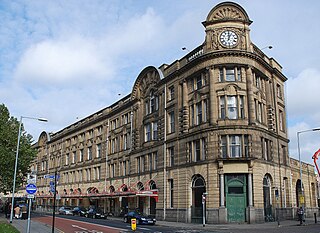
Manchester Victoria station in Manchester, England, is a combined mainline railway station and Metrolink tram stop. Situated to the north of the city centre on Hunts Bank, close to Manchester Cathedral, it adjoins Manchester Arena which was constructed on part of the former station site in the 1990s. Opened in 1844 and part of the Manchester station group, Victoria is Manchester's third busiest railway station after Piccadilly and Oxford Road and the second busiest station managed by Northern after Oxford Road.

Sheffield station is a combined railway station and tram stop in Sheffield, England; it is the busiest station in South Yorkshire. Adjacent is Sheffield station/Sheffield Hallam University Sheffield Supertram stop. In 2017–18, the station was the 43rd-busiest in the UK and the 15th-busiest outside London.
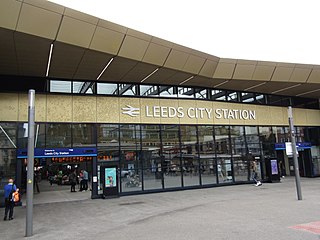
Leeds railway station is the mainline railway station serving the city centre of Leeds in West Yorkshire, England. It is the third-busiest railway station in the UK outside London. It is located on New Station Street to the south of City Square, at the foot of Park Row, behind the landmark Queens Hotel. It is one of 20 stations managed by Network Rail.

The Huddersfield line is the main railway line between the English cities of Leeds and Manchester, via Huddersfield. It is one of the busiest MetroTrain lines. The route travels south-south-west from Leeds through Dewsbury. After a short westward stretch through Mirfield, where it runs on the ex-L&YR section, it continues south-west through Huddersfield, using the Colne Valley to its headwaters. The long Standedge Tunnel, just after Marsden, crosses under the watershed; the majority of the run down to Manchester is in the Tame Valley. From Manchester, some services continue to Manchester Airport and others to Liverpool.

Wigan North Western railway station is one of two railway stations serving the town centre of Wigan, Greater Manchester, England.

The Manchester–Preston line runs from the city of Manchester to Preston, Lancashire, England. It is largely used by commuters entering Manchester from surrounding suburbs and cities, but is also one of the main railway lines in the North West and is utilised by TransPennine Express regional services and to Scotland. It was announced in December 2009 that the line would be electrified, following an announcement in July 2009 that the Chat Moss line between Manchester and Liverpool was to be electrified first. The electrification work for this line commenced in May 2015 and was due for completion in May 2018, but was delayed until December 2018.
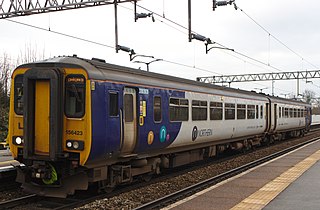
There once were four direct railway routes between Liverpool and Manchester in the North West of England; only two remain, the two centre routes of the four. The most northerly and the most southerly of the four routes are no longer direct lines. Of the remaining two direct routes, the northern route of the two is fully electric, while the now southern route is a diesel-only line. The most northerly of the four has been split into two routes: the western section operated by Merseyrail electric trains and the eastern section by diesel trains, requiring passengers to change trains between the two cities. The fourth route, the most southerly of the four, has been largely abandoned east of Warrington; the remaining section caters mainly for freight trains.

Manchester Airport station is a railway, tram, bus and coach station at Manchester Airport, England which opened at the same time as the second air terminal in 1993. The station is 9+3⁄4 miles (15.7 km) south of Manchester Piccadilly, at the end of a short branch from the Styal line via a triangular junction between Heald Green and Styal stations. Manchester Metrolink tram services were extended to the airport in 2014 and operate to Manchester Victoria.
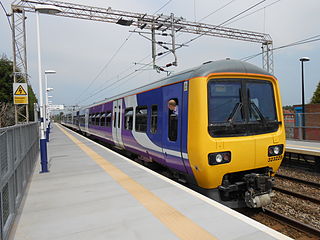
The Styal line is a suburban commuter railway line which runs through south Manchester, England; it commences at Slade Lane Junction, 1.2 miles (1.9 km) south of Manchester Piccadilly, and ends 12 miles (19 km) south at Wilmslow.

First TransPennine Express was a British train operating company jointly owned by FirstGroup and Keolis which operated the TransPennine Express franchise. First TransPennine Express ran regular Express regional railway services between the major cities of Northern England as well as Scotland.

Huyton railway station serves Huyton in Merseyside, England. The station is an interchange between the Liverpool-Wigan Line and the northern route of the Liverpool-Manchester Line which diverge soon after the station. It is one of the busier stations on the lines and close to the shopping centre and bus station.

The transport infrastructure of Greater Manchester is built up of numerous transport modes and forms an integral part of the structure of Greater Manchester and North West England – the most populated region outside of South East England which had approximately 301 million annual passenger journeys using either buses, planes, trains or trams in 2014. Its position as a national city of commerce, education and cultural importance means the city has one of the largest and most thorough transport infrastructures which is heavily relied upon by its 2.8 million inhabitants in the Greater Manchester conurbation and further afield in the North West region. Public transport comes under the jurisdiction of Transport for Greater Manchester.

Ordsall Chord, also known as the Castlefield Curve, is a short railway line in Ordsall, Salford, England, which links Manchester Piccadilly and Manchester Oxford Road to Manchester Victoria, designed to increase capacity and reduce journey times into and through Manchester. It allows trains to run from Leeds, Newcastle and Redcar Central direct to Manchester Airport.

High Speed 2 is a planned new high-speed railway line connecting London with the city centres of Birmingham, Manchester and Leeds directly on new high speed track. East Midlands Airport will also be served. The railway is to be delivered in two phases:
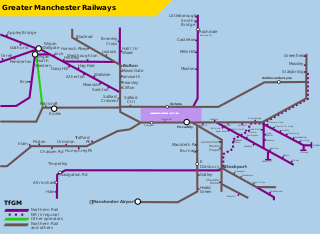
The Manchester station group is a station group of four railway stations in Manchester city centre, England; this consists of Manchester Piccadilly, Manchester Oxford Road, Manchester Victoria and Deansgate. The station group is printed on national railway tickets as MANCHESTER STNS. For passengers travelling from one of the 91 National Rail stations in Greater Manchester, the four stations are printed as MANCHESTER CTLZ which additionally permits the use of Metrolink tram services in Zone 1.

Manchester Airport High Speed Station was a planned High Speed 2 station at Manchester Airport, on the southern boundary of Manchester, England, next to Junction 5 of the M56 motorway on the northern side of the airport 1.5 miles (2.4 km) north-west of Manchester Airport railway station.

Northern Powerhouse Rail (NPR), sometimes referred to unofficially as High Speed 3, is a proposed major rail programme designed to substantially enhance the economic potential of the North of England. The phrase was adopted in 2014 for a project featuring new and significantly upgraded railway lines in the region. The aim is to transform rail services between the major towns and cities, requiring the region's single biggest transport investment since the Industrial Revolution. The original scheme would have seen a new high-speed rail line from Liverpool to Warrington continuing to join the HS2 tunnel which it would share into Manchester Piccadilly station. From there, the line would have continued to Leeds with a stop at Bradford. The line was intended to improve journey times and frequency between major Northern cities as well as creating more capacity for local service on lines that express services would have been moved out from.
The Northern Powerhouse was a proposal to boost economic growth in the North of England by the 2010–15 coalition government and 2015–2016 Conservative government in the United Kingdom, particularly in the "Core Cities" of Hull, Manchester, Liverpool, Leeds, Sheffield and Newcastle. The proposal was based on the benefits of agglomeration and aimed to reposition the British economy away from London and the South East; where most of the UK's wealth was historically concentrated. The spatial footprint of the Northern Powerhouse was defined as the 11 local enterprise partnership areas of the North of England.
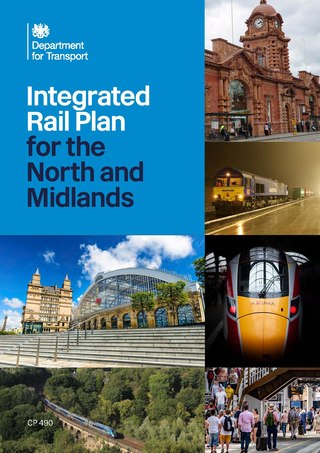
The Integrated Rail Plan for the North and Midlands or more simply, the Integrated Rail Plan (IRP), is a United Kingdom government proposal published on 18 November 2021. It aims to deliver "increased capacity, faster journeys or more frequent services on eight out of the top ten busiest rail corridors across the North and Midlands", by developing rail services along with the required infrastructure in these regions of England. It was published by the Department for Transport (DfT) and features forewords by Prime Minister Boris Johnson and Transport Secretary Grant Shapps, but its publication was delayed a number of times, partly because of the COVID-19 pandemic. It contains the significant proviso that "In line with the Government's existing approach to rail enhancements, commitments will be made only to progress individual schemes up to the next stage of development, subject to a review of their readiness." A Technical Annexe was published in January 2022. A correction slip was issued March 2022.



























